How to deal with the challenge of centralization? Vitalik releases fourth round of Gitcoin Grants analysis report
On January 28, 2020, Vitalik Buterin published an article called "Review of Gitcoin Quadratic Funding Round 4."
In the article, Vitalik briefly analyzed the results of this round of Quadratic Funding. More importantly, he also put forward some very valuable observations and analyses, including the value and reflection of centralization in Quadratic Funding. , How to increase the positive sum game, and the future of quadratic freelancers and so on.
There is another point worthy of our attention that Vitalik did not mention. Moleen's founder Ameen pointed out that in the top 5 technical funding of this Quadratic Funding, the first funding of 4 projects came from DAO, which proves DAO has been successful in identifying and delivering promising projects to the community. From this we can see that DAO is playing an increasingly important role in the entire web3 ecosystem.
Here is a full translation of Vitalik:
- Blockchain combines AI and sensors to open the era of intelligent industry
- CME Managing Director: CME Group Bitcoin Futures Trading Volume Reaches $ 100 Billion Since 2017
- The restless January finally passed, BSV rose 182% to lead the crypto market
Author: Vitalik Buterin
Translation: Typto
Gitcoin Grants's fourth round of second-party financing has just ended, with the following results:
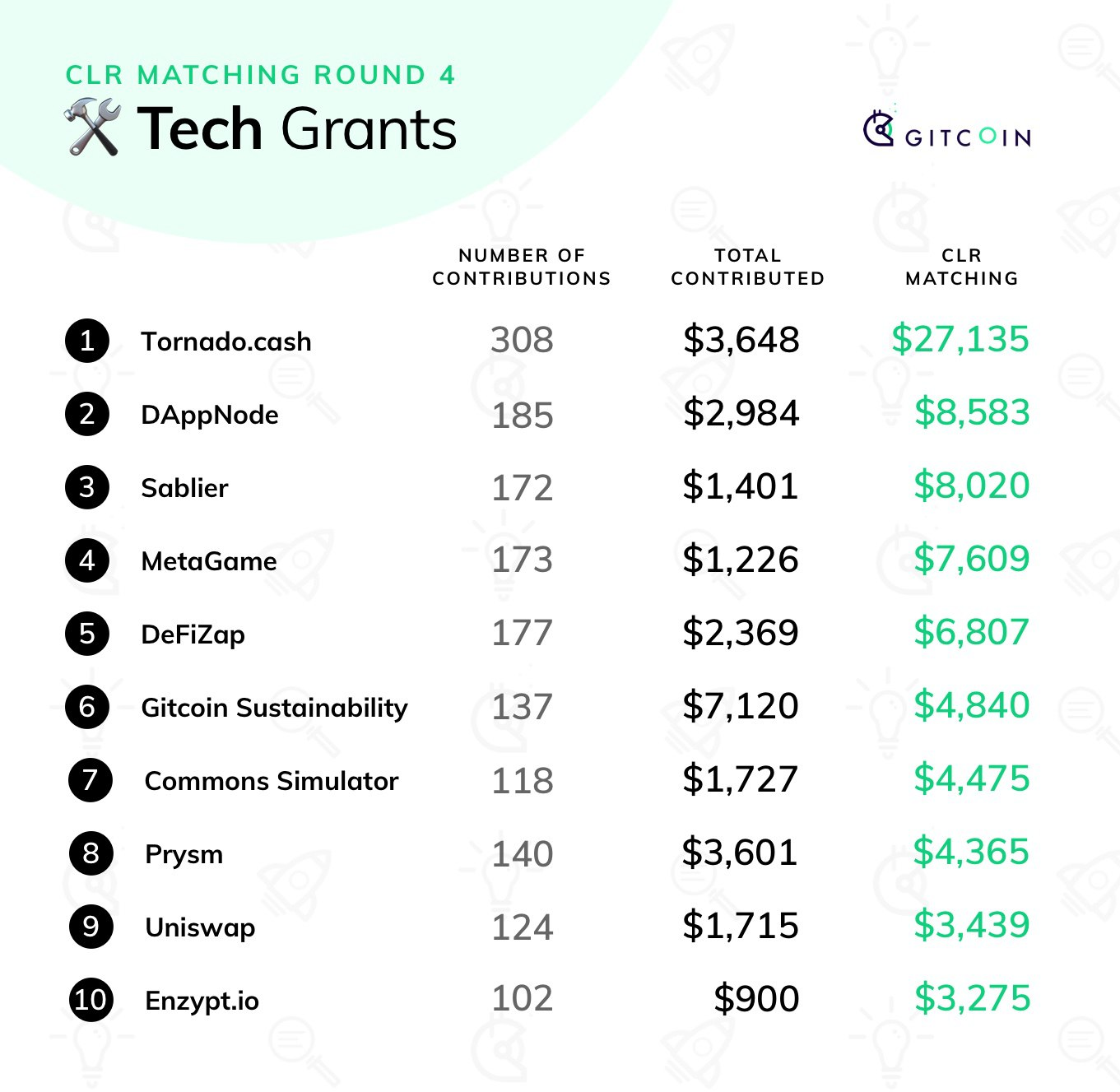
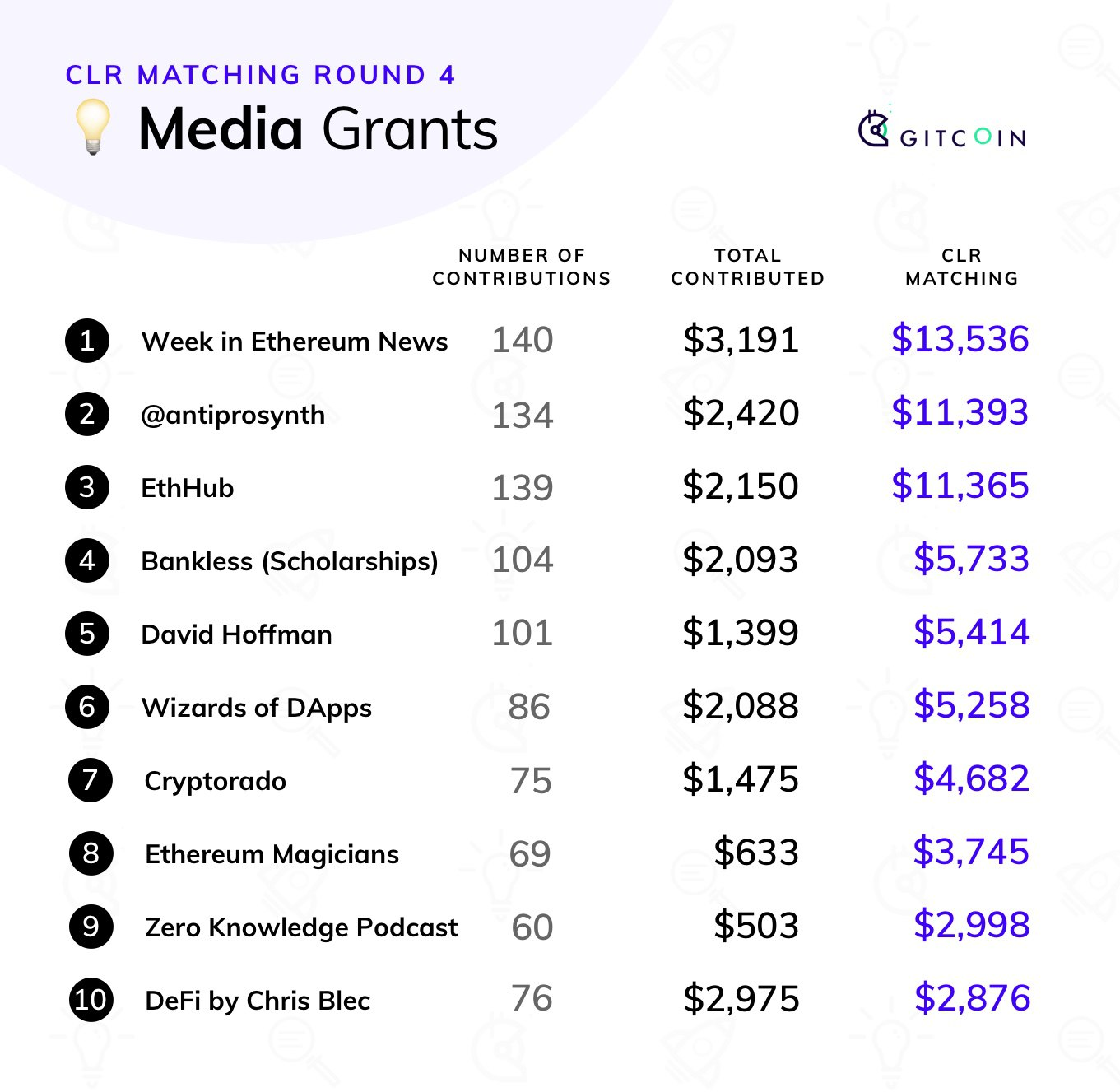 The main difference between round 4 and round 3 is that round 3 has only one category, most of which are technical projects, and a small number of special cases, such as EthHub, but round 4 has two independent categories, one is technology Category projects with a matching pool of $ 125,000, and the other is a "media" category project with a matching pool of $ 75,000. Among them, the media include documents, translations, community events, news reports, and anything that theoretically falls into this category. Technical projects are basically unpredictable, but the results of new media are much more interesting than I thought. It provides a new perspective on the deep problems in system design and politics.
The main difference between round 4 and round 3 is that round 3 has only one category, most of which are technical projects, and a small number of special cases, such as EthHub, but round 4 has two independent categories, one is technology Category projects with a matching pool of $ 125,000, and the other is a "media" category project with a matching pool of $ 75,000. Among them, the media include documents, translations, community events, news reports, and anything that theoretically falls into this category. Technical projects are basically unpredictable, but the results of new media are much more interesting than I thought. It provides a new perspective on the deep problems in system design and politics.
Technology: Quadratic financing works as well as before
The main changes we saw in the technical section compared to the third round are: (1) the growth of Tornado Cash and (2) the significant decline of the eth2 client, and the growth of various forms of "applications". Tornado Cash is an Ethereum Mixer based on smart contracts.
In recent months, Tornado Cash has quickly gained popularity due to concerns over the current low level of privacy of the blockchain and calls for solutions to sweep the Ethereum community. So far Tornado Cash has pooled a staggering $ 31,200, and if they continue to maintain such a magnitude of funding every two months, they can provide the two of them with $ 7,800 per person per month, which means that we expect the first A "quadratic freelance" milestone may have been achieved! Other major winners are tools like Dappnode (a package that helps people run nodes), Sablier (payment stream service), and DefiZap (improving the ease of use of DeFi services). The Gitcoin Sustainable Development Fund received more than $ 13,000, which finally solved the problem of insufficient Gitcoin funds I mentioned in the last round of financing . In short, the community really needs to provide valuable grant services for valuable projects.
We can see that this round has a major change compared to the previous rounds. In the previous rounds, the grants were mainly invested in projects such as the eth2 client that has received good support, and the largest grant in this round Paragraphs have shifted from the Ethereum Foundation to other focus. EF did not grant tornado.cash grants and limited their grants to application-specific tools, with Uniswap being the obvious exception. On the other hand, the Gitcoin Grants quadratic fund is supporting DeFiZap, Sablier, and many other valuable tools for the community. This is a positive move. It allows Gitcoin Grants and the Ethereum Foundation to complement each other instead of Focus on the same focus.
I hope to make a suggestion on the implementation of technical second-party financing, that is, the optimization of the user interface, so that users can more easily submit funds for multiple rounds of financing, which will increase the stability of contributions and thus the stability of project income. This is important if we want "quadratic freelancers" to be a viable job category!
Media: First Twitter Quadratic Freelancer
Now let ’s take a look at the new media section. In the first days of this round of funding, the lead recipient was “@antiprosynth Twitter Account Campaign”: a very active member of the Ethereum community on Twitter who promoted Ethereum, refuted Misinformation from the Bitcoin Maximizer, asking the Gitcoin QF crowd for help … to fund his tweet campaign. At its peak, @ antiprosynth's estimated match funding was more than $ 20,000, which would obviously be controversial, with many criticizing the move and questioning whether Twitter accounts are legitimate public goods:
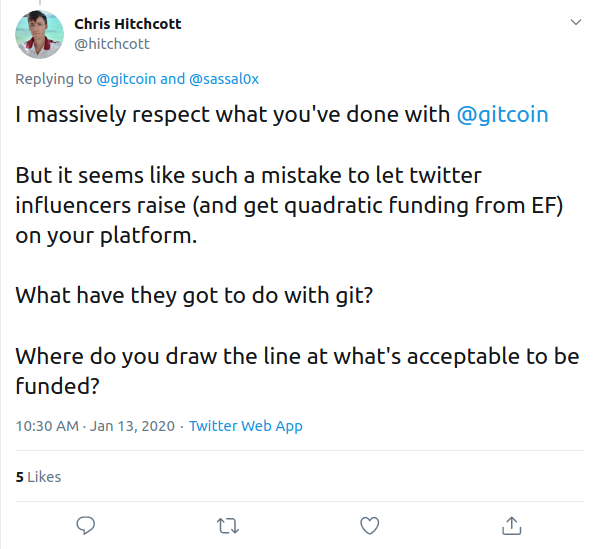
On the surface, it would be ridiculous to open a Twitter account for $ 20,000, but it's really worth our in-depth research and questioning: what's wrong with this result (if any). After all, maybe this is the reality of effective marketing in 2020, and we need to adapt.
I have heard two major objections that have spawned more interesting criticisms of quadratic financing in the current implementation process. First, there are criticisms of overpayment . Twitter is a fairly "trivial" activity, it doesn't require much work, many people are free, and it doesn't provide as long-term value as more substantial products like EthHub or zero-knowledge podcasts . It is therefore wrong to pay it full-time.
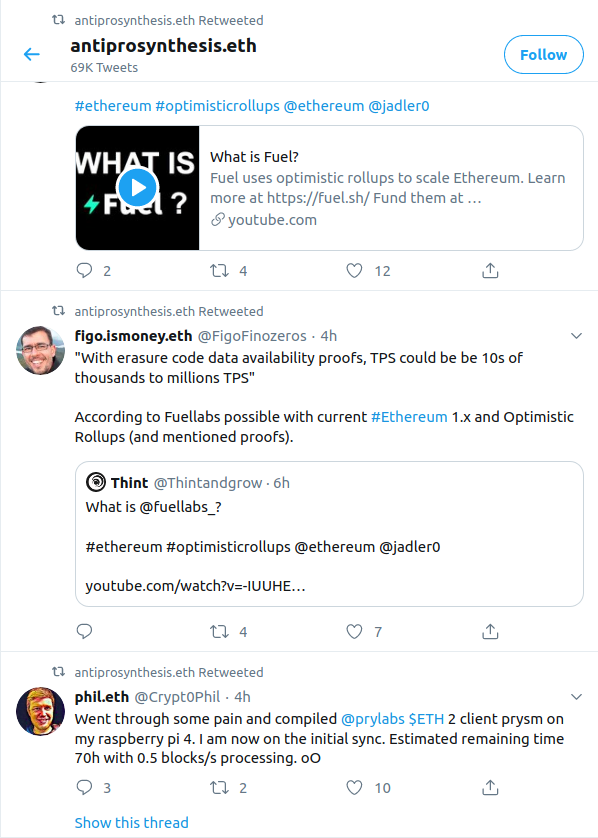
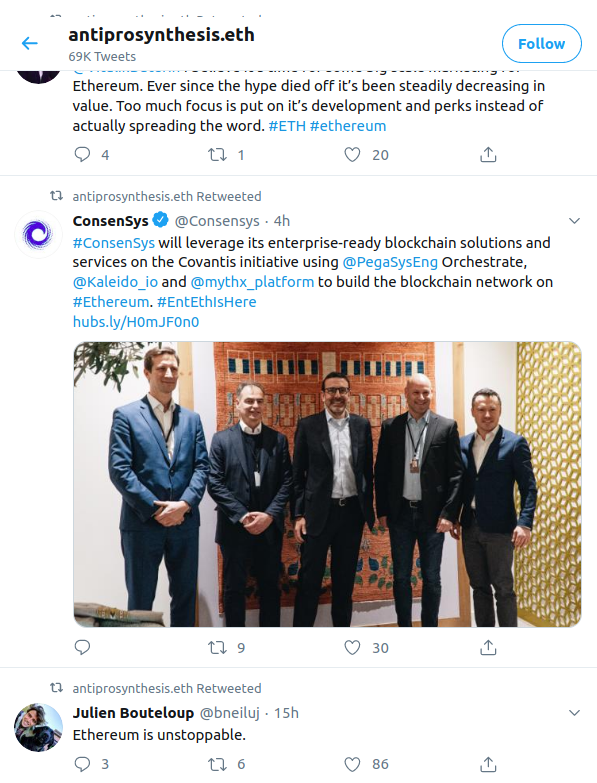

@ antiprosynth's recent tweet examples
If we accept this hypothesis and compare the quadratic financing to the public goods market , then we can simply extend this metaphor to respond to people's concerns with conventional free market arguments. People volunteering to support @ antiprosynth's twitter campaign has proven to be valuable in itself. Why should we believe that you can get real money from dozens of people just by your words and protests?
The most reasonable answer is actually very similar to the answer you often hear when discussing financial markets: when you can express an opinion in favor of something, but you cannot express an opinion against it, the market may give unjust results. When short selling is not possible, the efficiency of financial markets is often greatly reduced , because the market does not reflect the average value of the true value of assets, but rather the over-expected expectations of a few fanatical supporters. There is also an asymmetry in this quadratic financing version, because you can donate to support a project, but you can't oppose it by donating. Could this be the source of the problem?
We can ask further, why is it that this project is overpaid and not other projects? The most common answer I hear is: the exposure of twitter accounts is already very high, but client development teams like Nethermind cannot get a lot of publicity directly through their work, so they need to sell themselves, and the twitter account "Work" is essentially self-promotion. In addition, well-known twitter users get more quadratic quotas from their exposure, which further amplifies their advantages, which is an issue I mentioned in the third round of review .
Interestingly, in the case of ordinary (vanilla) quadratic voting, Glen Weyl put forward an argument why the economies of scale effect of traditional voting ( such as Dufferger's law ) does not apply to quadratic voting: if an item changes Being more outstanding will increase people's motivation to give it both positive and negative votes, so the net effect is actually offset, but please note again that this argument depends on the possibility of negative votes.
Is it good for the same race and the world?
In my opinion, the story of @antiprosynth has a happy ending: in the next ten days, more donations went to other candidates, and @ antiprosynth's quota fell to $ 11,116, although it was still quite high Amount, but on par with EthHub, under Week in Ethereum. However, even a quadratic matching grant of this size will still trigger the next criticism: Is the tweet a public good or a public nuisance?
By convention, the public goods that Gitcoin Grants attempts to fund should be selected and funded by the government. The motivation of @ antiprosynth's tweet is "to aggregate relevant news about Ethereum, counter information asymmetry, and unify Ethereum (and ETH). Fine-tuning / spreading ": In essence, this is a battle for justice against Ethereum misinformation caused by Bitcoin maximists . You see, governments also have a rich history of funding social media participants to defend themselves, and it seems that most of these governments consider themselves to be doing "just justice with the counter-misinformation of extremists, imperialists, and totalitarians." Battle ", just as the Ethereum community believes it is necessary to fight a just battle with extremist trolls. From the internal perspective of each country (the Ethereum community in our case), organized social media engagement seems to be a clear public interest (ignoring possible negative effects, which is real and important ), But from the perspective of the entire external world, it can be viewed as a zero-sum game.
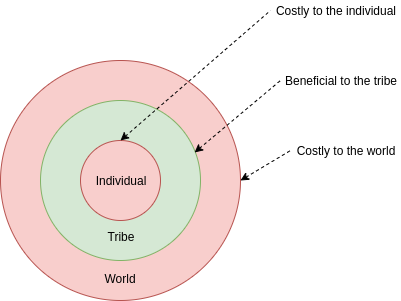
This is actually a common political model, and in fact there are many examples of large-scale coordination precisely to undermine small-scale coordination that is considered to be “beneficial to the same race but not to the world”: antitrust laws, free trade agreements, national level Pre-emptive rights, anti-militarization agreements … and many more. In the wider environment, public subsidies are generally considered suspicious, and of course they have also made a lot of efforts to limit all kinds of vicious local coordination. But as public goods become more and more important, and we find that the community ’s method of coordinating the manufacture of public goods is getting better and better, the effectiveness of this strategy is becoming more and more limited. The difference between "family-friendly" and "beneficial to the world" becomes even more important.
In other words, Internet marketing and debate are not zero-sum games. There are many ways to participate in Internet marketing and debate, which are beneficial to the world. Generally speaking, the role of online debate is to help the public understand what is true, what is not true, what are the reasons for support and what are the reasons for opposition. Some strategies are obviously not inclined to the truth, but others are inclined to the truth. Some tactics are clearly offensive, but others are defensive. There is a general view in the Ether community that there are not enough resources for some kind of marketing, and I personally agree with this view.
What kind of marketing is a positive-sum game (good for the same family and the world) and what kind of marketing is a zero-sum game (good for the same family, but not good for the world) is another issue that is worthy of community discussion. I certainly hope Ethereum The community continues to value the maintenance of ethical highlands. Regarding @ antiprosynth's own situation, I cannot find any reason that I think is harmful to the world, especially compared to our common blatant error messages against Ethereum (such as "it is impossible to run a full node"). But I support Ethereum, so I am biased and need to be careful.
General mechanism, specific goal
There is another plot in this story, revealing another feature (or bug?) Or quadratic financing. Quadratic financing was originally described as a "formal rule of social neutrality among communities" with the intention of using it on a large scale, and possibly even globally. Anyone can participate as a project party or participant, and any public product that is good for the "public" will be supported. However, in terms of Gitcoin grants, the matching funds come from the Ethereum organization, so people expect the system to support the Ethereum project. However, there is no rule in the quadratic financing rule that will give priority to Ethereum projects and exclude non-Ethereum projects. For example, the Ethereum Classic project is also using this platform to seek financing! Of course, this did happen:

So the result now is that the $ 24 funds provided by the Ethereum organization will be used to support the Twitter activities of Ethereum Classic promoters. In order to help people outside the cryptocurrency field understand the meaning, please imagine that the United States held a second-party financing, using government funds to match donations, and as a result, some funds went to a clear plan to use this money to talk about Russia on Twitter How great people are (and vice versa). The matching funds come from Ethereum, and there is a conventional expectation that these funds should support Ethereum. But in fact there is nothing that can prevent non-Ethereum project organizations from gaining a share of matching funds on the platform!
solution
There are two ways to solve these problems. One is to modify the second-party appropriation mechanism to support negative votes other than yes. The mathematical theory behind quadratic voting has shown that allowing this possibility is a "right thing" (each positive number has a negative square root and a positive square root). On the other hand, the society is worried that allowing negative votes will lead to more hatred and other types of harm. After all, the worst thing about the black people is to oppose something instead of supporting it, so my point is that I am not sure about allowing The opposition contribution is valid, but there is sufficient evidence that it may be worth trying in a future round of financing.
The second solution is to use two different mechanisms to identify the relative pros and cons of good projects and screen the poor projects. For example, you can use a challenge mechanism and then vote with a majority of ETH coins, or even start with a centralized commissioned board to screen for poor projects, and then use second-party financing to select good projects as before. This is not mathematically elegant, but it solves the problem, and it also provides an opportunity to fuse different mechanisms to ensure that selected projects benefit from Ethereum.
But even if we take the first solution, it should be a good idea to define a boundary for quadratic financing itself. This is academically precedent. In Elinor Ostrom's " eight principles for governing the commons", the first principle is to define who has the right to enter the lower house, Ostrom Writing without clear boundaries, "local funders face the risk that any benefit from their efforts will be reap by those who have not contributed to those efforts." Gitcoin grants One possibility of quadratic financing is to set the maximum matching coefficient of any pair of users to be proportional to the geometric average of their ETH holdings, and use this as a proxy for measuring the membership of the Ethereum community (note: this avoids The rich effect, because 1000 users with 1 ETH have a maximum match of ETH, while 2 users with 500 ETH also have a maximum match of ETH).
conspiracy
Another important issue in this round of financing is collusion. The mathematical principle behind quadratic financing is to amplify individual donations by the total amount and size of other donations to the same project, thereby compensating for the tragedy of the commons, however only valid when the actual tragedy of the commons limits natural donations to the project . If there is an "exchange condition" where people exchange something one by one for their contribution, the mechanism is easily overcompensated. In this regard, the long-term solution is similar to MACI , which is an encryption system that ensures that contributors cannot prove their contribution to third parties, so any such collusion must be done by the honor system. However, there is no corresponding rule formulation and implementation in the short term, which has led to a heated debate about which alternative is legal:
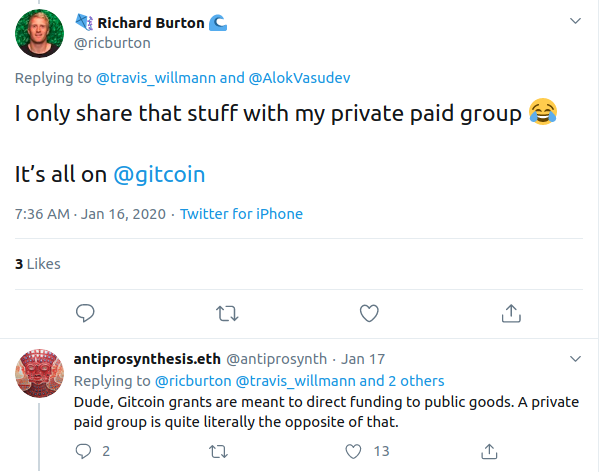
[Update 2020.01.29: The above is ultimately due to poor communication with Gitcoin ; a member of the Gitcoin group has agreed with Richard Burton's proposal to provide bonuses to donors without realizing its meaning, so Richard himself is not Sinful. Although more broadly, we underestimate the very real need to “clearly guide what exchange terms are acceptable”. ]
The current position is that "exchange terms" are not allowed, and although there is a little more subtle feeling, informal social "exchange terms" (different forms of "thank you") are acceptable, but formal, especially money Or product rewards are not allowed. This seems to be a reasonable attitude, although it does put Gitcoin further into the embarrassing situation of centralization, which to some extent undermines credible neutrality . However, the entire discussion brought an unexpected surprise, which allowed the Ethereum community to have a better understanding of what is the real public interest (relative to "personal interest" or "group interest"), and more widely the public goods Brought into public discussion.
in conclusion
Although the third round is the first round with enough participants to produce any kind of interesting effect, the fourth round really feels like a "coming out party" for decentralized public product financing. This round of financing has attracted a lot of attention from the community, and even attracted attention from some external fields such as the Bitcoin community. This is part of a megatrend in the past few months: Public product financing has become an important part of the discussions in the crypto community. Along with this, we also saw more strategic discussions about the long-term funding sources of large-scale quadratic matching pools.
The discussion of funding will be very important in the future: donations from large Ethereum organizations are sufficient to maintain the current quadratic match size, but not enough to allow it to grow further, so that we can have hundreds of quadratic freelancers. Not just the five now (probably). At this scale, the source of funds for Ethereum's public goods must depend on network effects to a certain extent, otherwise they will not have more staying power than individual donations, but we have good reasons to believe that these funds should not be used. Sources are embedded too deeply into Ethereum (for example, into the agreement itself, as in the recent BCH proposal ) to avoid endangering the neutrality of the agreement.
Based on the method of obtaining transaction fees in layer 2 is surprisingly feasible: currently Ethereum generates approximately 50,000-100,000 US dollars (about 18-35 million US dollars) of transaction costs per day, which is roughly equivalent to the entire Ethereum Foundation's budget, with additional evidence It shows that the minable value of miners is even higher . If we want the Ethereum community to be a leader in implementing the challenges of decentralized, credible neutral, and market-based public product financing, then we need to have all the discussions and challenges.
Original address: https://vitalik.ca/general/2020/01/28/round4.html
We will continue to update Blocking; if you have any questions or suggestions, please contact us!
Was this article helpful?
93 out of 132 found this helpful
Related articles
- Thin application: comprehensive upgrade of the "fat protocol" of blockchain value capture theory
- Are Trezor wallets no longer secure? In just 15 minutes, hackers can steal private keys through physical access
- Learning | What are the businesses of stablecoin (2)
- Market analysis: Bakkt's bitcoin options performance is weak. Will the halving in May usher in a turnaround?
- Ten billion dollars market! How does blockchain empower digital art?
- Creating a national-level payment portal, Cambodia will launch a blockchain-based digital currency
- Under the epidemic | The attacking digital age——Blockchain events






